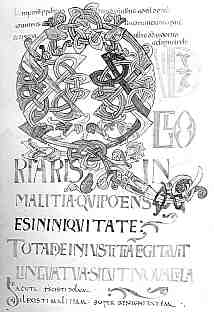


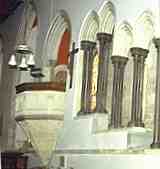
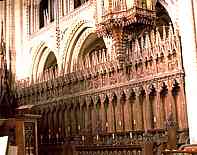
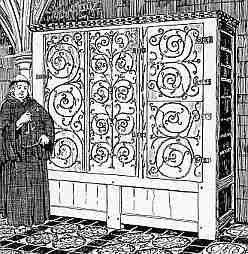
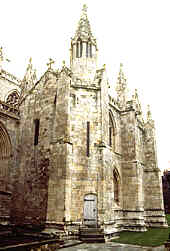
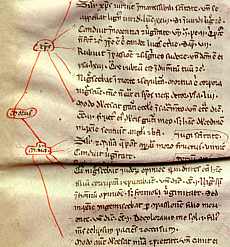
If you are looking at this page without frames, there is more information about medieval writing to be found by going to the home page (framed) or the site map (no frames).
| Modes of Reading in the Middle Ages (3) | ||||
| As part of their reform of scripts, the literate monks of the Carolingian age abandoned the fanciful heading scripts of the preceding era, and reintroduced the majuscule scripts from antiquity, square capitals, rustic capitals and uncial, to form a hierarchy of heading scripts. These became the standard until the introduction of new forms in the Gothic era. Significant chapter beginnings were differentiated into large graphic chunks, providing a link between pattern and design, words and memory. Headings, while differentiated in weight and majesty, were no longer tangled into anagrams and tricky designs, but legible as text. |  |
|||
| First page of Psalm 51 in a late 10th century psalter (British Library, add ms 37517, f.33). (From New Palaeographical Society 1909) | ||||
 |
Segment of one column from the two column text of the Ada Gospels of the late 8th century (Treves, Stadtbibliothek, Bibelhandschriften 22 (Codex aureus), p.17). (From Steffens 1929) | |||
| The increasing use of double column text rather than a single column written across the width of the page may have reduced the necessity to track back and forwards with the eyes and allowed the mental processing of chunks of text, rather than individual letters or even single words. Enlarged capitals at the beginning of paragraphs and the use of historiated initials to provide a visual clue as to the content of the text also aided in this process, for those who were highly literate in Latin, of course. | ||||
| This heightening of legibility went along with regularisation of texts themselves. Efforts were made over several centuries to replace various Old Latin versions of the Bible with St Jerome's Vulgate. Fine exemplars were produced and presented to major churches and monasteries to remove errors which had been perpetuated in old texts. The works of the Latin Classics and the Latin grammarians were reproduced and studied to aid in the study of the language and the correction of texts. Herein lies a little conundrum. When we talk about the phonetic qualities and grammatical regularity of the Latin language, we are talking about texts which have already passed through this very conscious filter, as they are largely known to us from medieval copies. Conspiracy theorists have suggested that the Latin Classics were forged by medieval monks. That is seriously unlikely, but one does wonder whether the precision of the Latin language, and adherence to the ideals of the theoretical grammarians, was enhanced by them in their quest for reading literacy. | ||||
 |
Various forms of reading were recognised in the middle ages. Reading in complete silence was the accomplishment of the scholar. Reading quietly aloud or mumbling was accepted as a means of reading for meditative purposes, or for committing text to memory. Reading aloud in public was part of the profession of the clergy. They declaimed the liturgy, read texts and sermons for the benefit of the congregation in church, and selected brethren in the monasteries read aloud to the others during meals. This was laid down in the Rule of St Benedict to discourage idle talk at table and for their moral improvement and education. Different forms of text developed to cater for different modes of reading. | |||
 |
At left, the refectory pulpit of Beaulieu Abbey in Hampshire. At right, the choir stalls of Ely Cathedral, where the liturgy was pronounced. |  |
||
| In these situations, not only the person who read aloud was a reader. The listeners were readers as well, learning from a written text. Medieval sources sometimes use reading and hearing as terms of very similar meaning. A person could read with their ears, whether in church, at university or in a court of law. This implies that a person who hears a text should be able to comprehend and analyse it as clearly as one who studies it through the decoding of graphic signs. | ||||
| It is believed that the library or scriptorium, in the form of a separate large room, did not become a feature of the Benedictine monastery until the 13th or 14th century. Before that, books were stored in a cupboard or aumbry, and loaned out to monks for reading in some quiet corner of the cloister or suchlike. Public reading, hearing or oral learning of text was thus separated from private reading as an activity. |  |
|||
| Depiction of an old aumbry in St Werburgh's Abbey, Chester. | ||||
 |
The late medieval scriptorium of Selby Abbey, a Benedictine house, occupied the upper floor of this annex to the church. | |||
| Petrucci (Petrucci 1995) ascribes the invention of the large reading and writing room to the new orders of friars in the 13th century, notably the Dominicans for whom scholarship was a work for God. The communal reading room with large benches and shelves of chained books is not derived from the origins of Benedictine monasticism, but from the new engagement of preaching orders with the laity, and the need of the friars to interpret texts for their moral improvement. The Dominicans introduced their own grammar of legibility, with new forms of punctuation in order to render more precisely their texts in oral form for those who read with their ears. | ||||
| Nevertheless, the library or scriptorium in this form became a feature of Benedictine monasteries. Intriguingly, this seems to have occurred at around that time that monasteries were transcribing fewer of their own books, but buying them from stationers and booksellers. Reading and study in a communal environment was becoming valued over solitary writing. | ||||
| For those heavily engaged with private acts of scholarship, written text became more dense, compact, abbreviated and complex. The script used for glosses, those scholarly annotations to core texts which sometimes overwhelmed them on the page, was similar to that used for compact Bibles and university writings such as law texts. The very page design became complex, with text in various blocks, sometimes connected with little marginal pointers which could snake around the core text indicating relevant sections. Reading was entirely a process of decoding written words, but the sequence was not necessarily linear. |  |
|||
| Segment from an early 14th century page of a work by Albertus Magnus on the Virgin Mary, from a private collection. | ||||
| The above example has intensive abbreviation, a script almost too tiny to read, and an assortment of marginal pointers and annotations. | ||||
| During the period of Gothic script, writing continued to develop certain graphic qualities which aided the more rapid comprehension of whole words. These included dotting the letter i, initially only if it was in a row of confusing minims, and extending the second i of double i into a letter like a j, as in the word filiis. Hyphenation was introduced when words carried on from one line to the next. The reading of a medieval Latin text involves the comprehension of a whole graphic code as well as the Latin language. | ||||
|
|
||||
|
If you are looking at this page without frames, there is more information about medieval writing to be found by going to the home page (framed) or the site map (no frames). |
||||